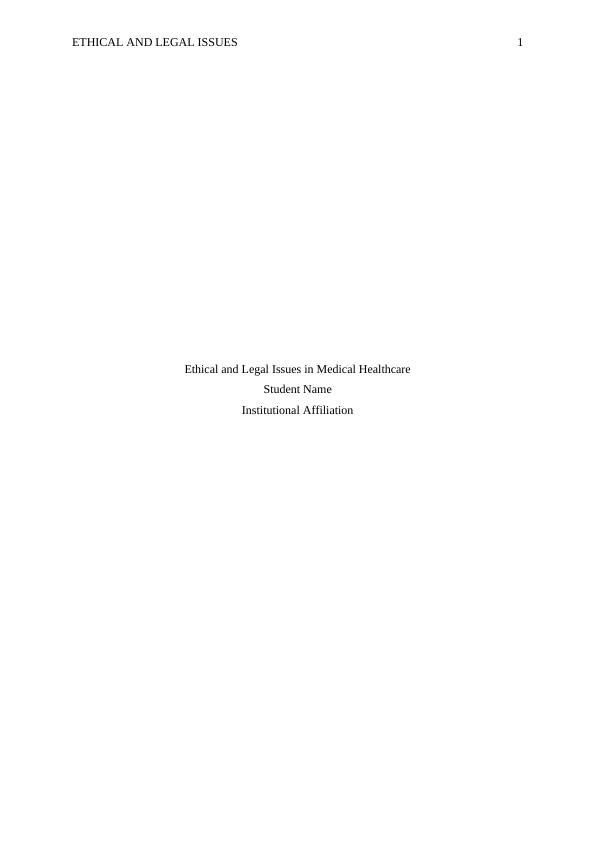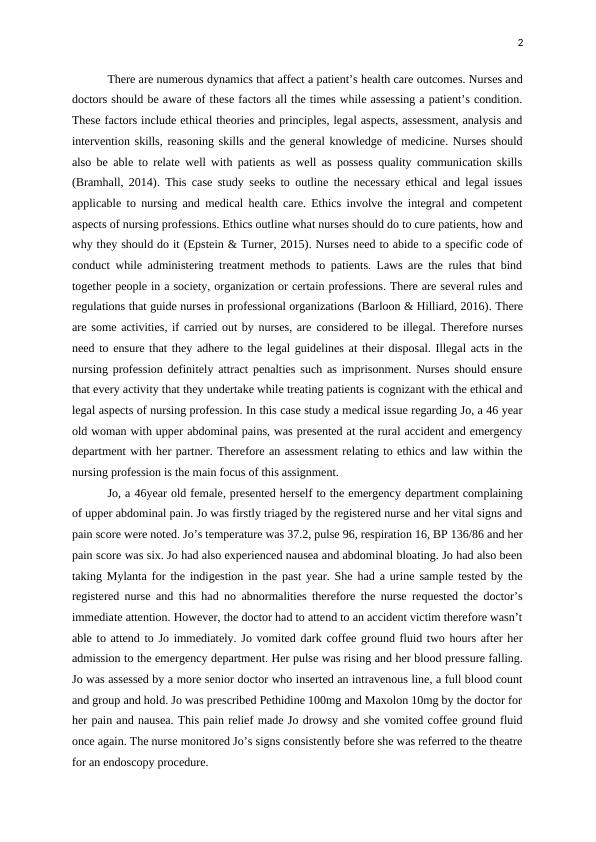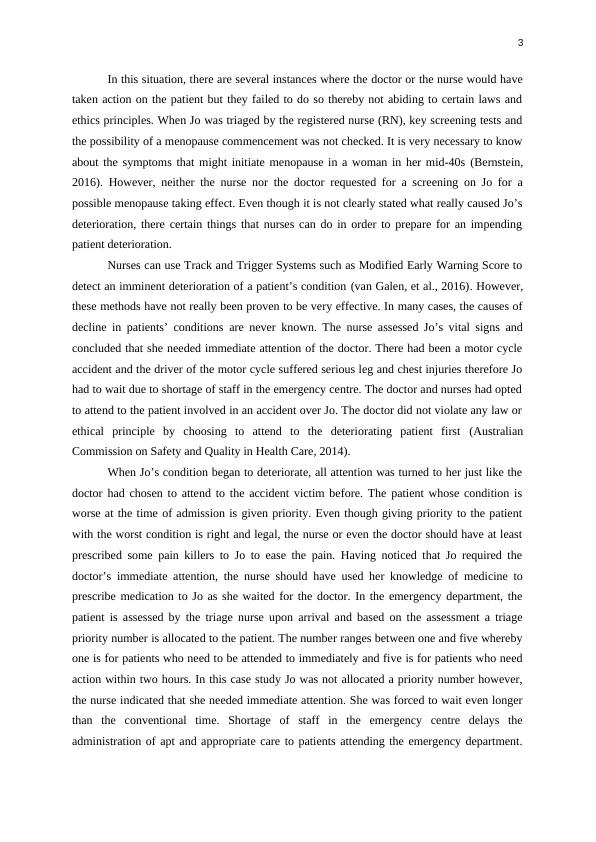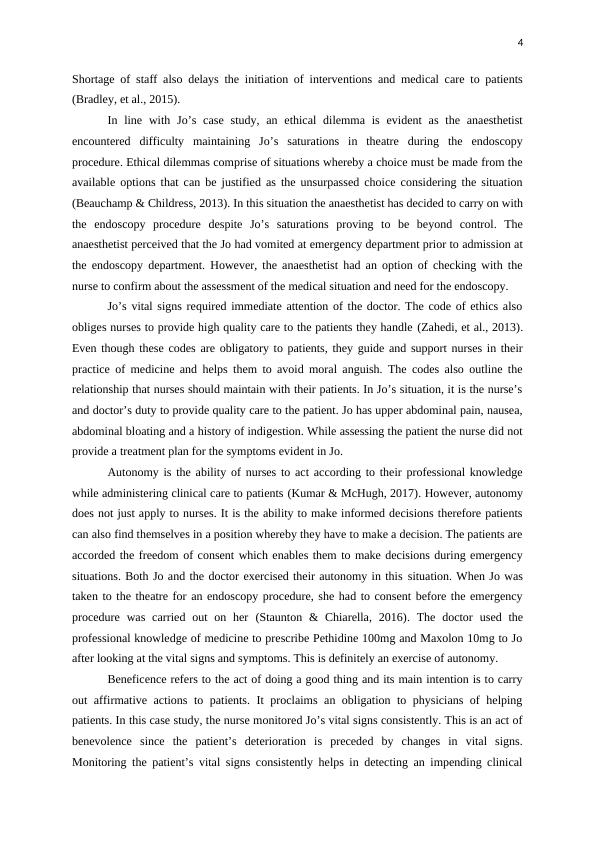Ethical and Legal Issues in Medical Healthcare
Added on 2023-06-05
11 Pages4403 Words412 Views
ETHICAL AND LEGAL ISSUES 1
Ethical and Legal Issues in Medical Healthcare
Student Name
Institutional Affiliation
Ethical and Legal Issues in Medical Healthcare
Student Name
Institutional Affiliation

2
There are numerous dynamics that affect a patient’s health care outcomes. Nurses and
doctors should be aware of these factors all the times while assessing a patient’s condition.
These factors include ethical theories and principles, legal aspects, assessment, analysis and
intervention skills, reasoning skills and the general knowledge of medicine. Nurses should
also be able to relate well with patients as well as possess quality communication skills
(Bramhall, 2014). This case study seeks to outline the necessary ethical and legal issues
applicable to nursing and medical health care. Ethics involve the integral and competent
aspects of nursing professions. Ethics outline what nurses should do to cure patients, how and
why they should do it (Epstein & Turner, 2015). Nurses need to abide to a specific code of
conduct while administering treatment methods to patients. Laws are the rules that bind
together people in a society, organization or certain professions. There are several rules and
regulations that guide nurses in professional organizations (Barloon & Hilliard, 2016). There
are some activities, if carried out by nurses, are considered to be illegal. Therefore nurses
need to ensure that they adhere to the legal guidelines at their disposal. Illegal acts in the
nursing profession definitely attract penalties such as imprisonment. Nurses should ensure
that every activity that they undertake while treating patients is cognizant with the ethical and
legal aspects of nursing profession. In this case study a medical issue regarding Jo, a 46 year
old woman with upper abdominal pains, was presented at the rural accident and emergency
department with her partner. Therefore an assessment relating to ethics and law within the
nursing profession is the main focus of this assignment.
Jo, a 46year old female, presented herself to the emergency department complaining
of upper abdominal pain. Jo was firstly triaged by the registered nurse and her vital signs and
pain score were noted. Jo’s temperature was 37.2, pulse 96, respiration 16, BP 136/86 and her
pain score was six. Jo had also experienced nausea and abdominal bloating. Jo had also been
taking Mylanta for the indigestion in the past year. She had a urine sample tested by the
registered nurse and this had no abnormalities therefore the nurse requested the doctor’s
immediate attention. However, the doctor had to attend to an accident victim therefore wasn’t
able to attend to Jo immediately. Jo vomited dark coffee ground fluid two hours after her
admission to the emergency department. Her pulse was rising and her blood pressure falling.
Jo was assessed by a more senior doctor who inserted an intravenous line, a full blood count
and group and hold. Jo was prescribed Pethidine 100mg and Maxolon 10mg by the doctor for
her pain and nausea. This pain relief made Jo drowsy and she vomited coffee ground fluid
once again. The nurse monitored Jo’s signs consistently before she was referred to the theatre
for an endoscopy procedure.
There are numerous dynamics that affect a patient’s health care outcomes. Nurses and
doctors should be aware of these factors all the times while assessing a patient’s condition.
These factors include ethical theories and principles, legal aspects, assessment, analysis and
intervention skills, reasoning skills and the general knowledge of medicine. Nurses should
also be able to relate well with patients as well as possess quality communication skills
(Bramhall, 2014). This case study seeks to outline the necessary ethical and legal issues
applicable to nursing and medical health care. Ethics involve the integral and competent
aspects of nursing professions. Ethics outline what nurses should do to cure patients, how and
why they should do it (Epstein & Turner, 2015). Nurses need to abide to a specific code of
conduct while administering treatment methods to patients. Laws are the rules that bind
together people in a society, organization or certain professions. There are several rules and
regulations that guide nurses in professional organizations (Barloon & Hilliard, 2016). There
are some activities, if carried out by nurses, are considered to be illegal. Therefore nurses
need to ensure that they adhere to the legal guidelines at their disposal. Illegal acts in the
nursing profession definitely attract penalties such as imprisonment. Nurses should ensure
that every activity that they undertake while treating patients is cognizant with the ethical and
legal aspects of nursing profession. In this case study a medical issue regarding Jo, a 46 year
old woman with upper abdominal pains, was presented at the rural accident and emergency
department with her partner. Therefore an assessment relating to ethics and law within the
nursing profession is the main focus of this assignment.
Jo, a 46year old female, presented herself to the emergency department complaining
of upper abdominal pain. Jo was firstly triaged by the registered nurse and her vital signs and
pain score were noted. Jo’s temperature was 37.2, pulse 96, respiration 16, BP 136/86 and her
pain score was six. Jo had also experienced nausea and abdominal bloating. Jo had also been
taking Mylanta for the indigestion in the past year. She had a urine sample tested by the
registered nurse and this had no abnormalities therefore the nurse requested the doctor’s
immediate attention. However, the doctor had to attend to an accident victim therefore wasn’t
able to attend to Jo immediately. Jo vomited dark coffee ground fluid two hours after her
admission to the emergency department. Her pulse was rising and her blood pressure falling.
Jo was assessed by a more senior doctor who inserted an intravenous line, a full blood count
and group and hold. Jo was prescribed Pethidine 100mg and Maxolon 10mg by the doctor for
her pain and nausea. This pain relief made Jo drowsy and she vomited coffee ground fluid
once again. The nurse monitored Jo’s signs consistently before she was referred to the theatre
for an endoscopy procedure.

3
In this situation, there are several instances where the doctor or the nurse would have
taken action on the patient but they failed to do so thereby not abiding to certain laws and
ethics principles. When Jo was triaged by the registered nurse (RN), key screening tests and
the possibility of a menopause commencement was not checked. It is very necessary to know
about the symptoms that might initiate menopause in a woman in her mid-40s (Bernstein,
2016). However, neither the nurse nor the doctor requested for a screening on Jo for a
possible menopause taking effect. Even though it is not clearly stated what really caused Jo’s
deterioration, there certain things that nurses can do in order to prepare for an impending
patient deterioration.
Nurses can use Track and Trigger Systems such as Modified Early Warning Score to
detect an imminent deterioration of a patient’s condition (van Galen, et al., 2016). However,
these methods have not really been proven to be very effective. In many cases, the causes of
decline in patients’ conditions are never known. The nurse assessed Jo’s vital signs and
concluded that she needed immediate attention of the doctor. There had been a motor cycle
accident and the driver of the motor cycle suffered serious leg and chest injuries therefore Jo
had to wait due to shortage of staff in the emergency centre. The doctor and nurses had opted
to attend to the patient involved in an accident over Jo. The doctor did not violate any law or
ethical principle by choosing to attend to the deteriorating patient first (Australian
Commission on Safety and Quality in Health Care, 2014).
When Jo’s condition began to deteriorate, all attention was turned to her just like the
doctor had chosen to attend to the accident victim before. The patient whose condition is
worse at the time of admission is given priority. Even though giving priority to the patient
with the worst condition is right and legal, the nurse or even the doctor should have at least
prescribed some pain killers to Jo to ease the pain. Having noticed that Jo required the
doctor’s immediate attention, the nurse should have used her knowledge of medicine to
prescribe medication to Jo as she waited for the doctor. In the emergency department, the
patient is assessed by the triage nurse upon arrival and based on the assessment a triage
priority number is allocated to the patient. The number ranges between one and five whereby
one is for patients who need to be attended to immediately and five is for patients who need
action within two hours. In this case study Jo was not allocated a priority number however,
the nurse indicated that she needed immediate attention. She was forced to wait even longer
than the conventional time. Shortage of staff in the emergency centre delays the
administration of apt and appropriate care to patients attending the emergency department.
In this situation, there are several instances where the doctor or the nurse would have
taken action on the patient but they failed to do so thereby not abiding to certain laws and
ethics principles. When Jo was triaged by the registered nurse (RN), key screening tests and
the possibility of a menopause commencement was not checked. It is very necessary to know
about the symptoms that might initiate menopause in a woman in her mid-40s (Bernstein,
2016). However, neither the nurse nor the doctor requested for a screening on Jo for a
possible menopause taking effect. Even though it is not clearly stated what really caused Jo’s
deterioration, there certain things that nurses can do in order to prepare for an impending
patient deterioration.
Nurses can use Track and Trigger Systems such as Modified Early Warning Score to
detect an imminent deterioration of a patient’s condition (van Galen, et al., 2016). However,
these methods have not really been proven to be very effective. In many cases, the causes of
decline in patients’ conditions are never known. The nurse assessed Jo’s vital signs and
concluded that she needed immediate attention of the doctor. There had been a motor cycle
accident and the driver of the motor cycle suffered serious leg and chest injuries therefore Jo
had to wait due to shortage of staff in the emergency centre. The doctor and nurses had opted
to attend to the patient involved in an accident over Jo. The doctor did not violate any law or
ethical principle by choosing to attend to the deteriorating patient first (Australian
Commission on Safety and Quality in Health Care, 2014).
When Jo’s condition began to deteriorate, all attention was turned to her just like the
doctor had chosen to attend to the accident victim before. The patient whose condition is
worse at the time of admission is given priority. Even though giving priority to the patient
with the worst condition is right and legal, the nurse or even the doctor should have at least
prescribed some pain killers to Jo to ease the pain. Having noticed that Jo required the
doctor’s immediate attention, the nurse should have used her knowledge of medicine to
prescribe medication to Jo as she waited for the doctor. In the emergency department, the
patient is assessed by the triage nurse upon arrival and based on the assessment a triage
priority number is allocated to the patient. The number ranges between one and five whereby
one is for patients who need to be attended to immediately and five is for patients who need
action within two hours. In this case study Jo was not allocated a priority number however,
the nurse indicated that she needed immediate attention. She was forced to wait even longer
than the conventional time. Shortage of staff in the emergency centre delays the
administration of apt and appropriate care to patients attending the emergency department.

4
Shortage of staff also delays the initiation of interventions and medical care to patients
(Bradley, et al., 2015).
In line with Jo’s case study, an ethical dilemma is evident as the anaesthetist
encountered difficulty maintaining Jo’s saturations in theatre during the endoscopy
procedure. Ethical dilemmas comprise of situations whereby a choice must be made from the
available options that can be justified as the unsurpassed choice considering the situation
(Beauchamp & Childress, 2013). In this situation the anaesthetist has decided to carry on with
the endoscopy procedure despite Jo’s saturations proving to be beyond control. The
anaesthetist perceived that the Jo had vomited at emergency department prior to admission at
the endoscopy department. However, the anaesthetist had an option of checking with the
nurse to confirm about the assessment of the medical situation and need for the endoscopy.
Jo’s vital signs required immediate attention of the doctor. The code of ethics also
obliges nurses to provide high quality care to the patients they handle (Zahedi, et al., 2013).
Even though these codes are obligatory to patients, they guide and support nurses in their
practice of medicine and helps them to avoid moral anguish. The codes also outline the
relationship that nurses should maintain with their patients. In Jo’s situation, it is the nurse’s
and doctor’s duty to provide quality care to the patient. Jo has upper abdominal pain, nausea,
abdominal bloating and a history of indigestion. While assessing the patient the nurse did not
provide a treatment plan for the symptoms evident in Jo.
Autonomy is the ability of nurses to act according to their professional knowledge
while administering clinical care to patients (Kumar & McHugh, 2017). However, autonomy
does not just apply to nurses. It is the ability to make informed decisions therefore patients
can also find themselves in a position whereby they have to make a decision. The patients are
accorded the freedom of consent which enables them to make decisions during emergency
situations. Both Jo and the doctor exercised their autonomy in this situation. When Jo was
taken to the theatre for an endoscopy procedure, she had to consent before the emergency
procedure was carried out on her (Staunton & Chiarella, 2016). The doctor used the
professional knowledge of medicine to prescribe Pethidine 100mg and Maxolon 10mg to Jo
after looking at the vital signs and symptoms. This is definitely an exercise of autonomy.
Beneficence refers to the act of doing a good thing and its main intention is to carry
out affirmative actions to patients. It proclaims an obligation to physicians of helping
patients. In this case study, the nurse monitored Jo’s vital signs consistently. This is an act of
benevolence since the patient’s deterioration is preceded by changes in vital signs.
Monitoring the patient’s vital signs consistently helps in detecting an impending clinical
Shortage of staff also delays the initiation of interventions and medical care to patients
(Bradley, et al., 2015).
In line with Jo’s case study, an ethical dilemma is evident as the anaesthetist
encountered difficulty maintaining Jo’s saturations in theatre during the endoscopy
procedure. Ethical dilemmas comprise of situations whereby a choice must be made from the
available options that can be justified as the unsurpassed choice considering the situation
(Beauchamp & Childress, 2013). In this situation the anaesthetist has decided to carry on with
the endoscopy procedure despite Jo’s saturations proving to be beyond control. The
anaesthetist perceived that the Jo had vomited at emergency department prior to admission at
the endoscopy department. However, the anaesthetist had an option of checking with the
nurse to confirm about the assessment of the medical situation and need for the endoscopy.
Jo’s vital signs required immediate attention of the doctor. The code of ethics also
obliges nurses to provide high quality care to the patients they handle (Zahedi, et al., 2013).
Even though these codes are obligatory to patients, they guide and support nurses in their
practice of medicine and helps them to avoid moral anguish. The codes also outline the
relationship that nurses should maintain with their patients. In Jo’s situation, it is the nurse’s
and doctor’s duty to provide quality care to the patient. Jo has upper abdominal pain, nausea,
abdominal bloating and a history of indigestion. While assessing the patient the nurse did not
provide a treatment plan for the symptoms evident in Jo.
Autonomy is the ability of nurses to act according to their professional knowledge
while administering clinical care to patients (Kumar & McHugh, 2017). However, autonomy
does not just apply to nurses. It is the ability to make informed decisions therefore patients
can also find themselves in a position whereby they have to make a decision. The patients are
accorded the freedom of consent which enables them to make decisions during emergency
situations. Both Jo and the doctor exercised their autonomy in this situation. When Jo was
taken to the theatre for an endoscopy procedure, she had to consent before the emergency
procedure was carried out on her (Staunton & Chiarella, 2016). The doctor used the
professional knowledge of medicine to prescribe Pethidine 100mg and Maxolon 10mg to Jo
after looking at the vital signs and symptoms. This is definitely an exercise of autonomy.
Beneficence refers to the act of doing a good thing and its main intention is to carry
out affirmative actions to patients. It proclaims an obligation to physicians of helping
patients. In this case study, the nurse monitored Jo’s vital signs consistently. This is an act of
benevolence since the patient’s deterioration is preceded by changes in vital signs.
Monitoring the patient’s vital signs consistently helps in detecting an impending clinical

End of preview
Want to access all the pages? Upload your documents or become a member.
Related Documents
Law and Ethics in Health - Case Studylg...
|12
|3883
|48
Consideration of patient situation Case Study 2022lg...
|10
|2556
|38
Report about What is Nursing? 2022lg...
|11
|2777
|26
ISBAR Plan of Care | Pain and Loss of Bloodlg...
|4
|584
|202
The Common Causes of Acute Pancreatitislg...
|5
|871
|17
Law and Ethics in Nursinglg...
|12
|3610
|97
